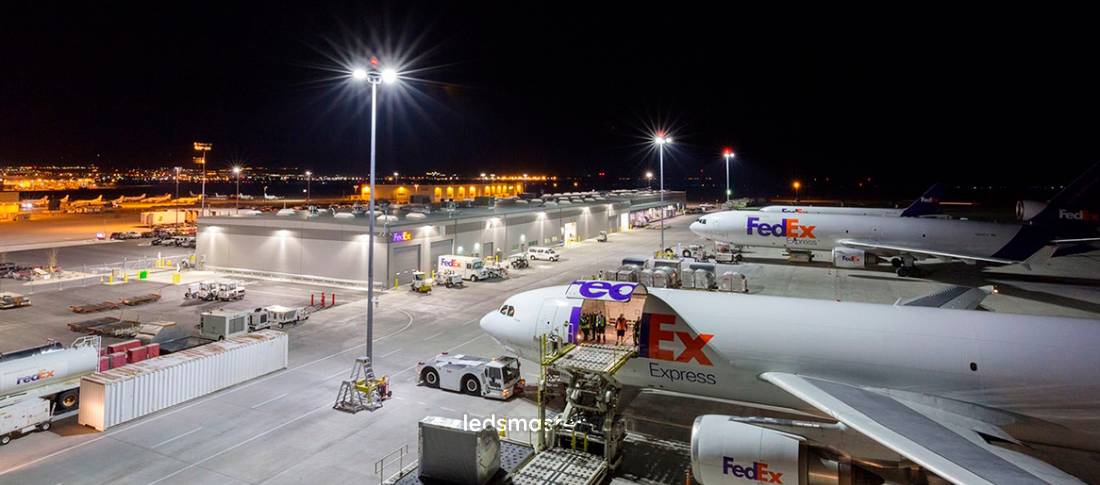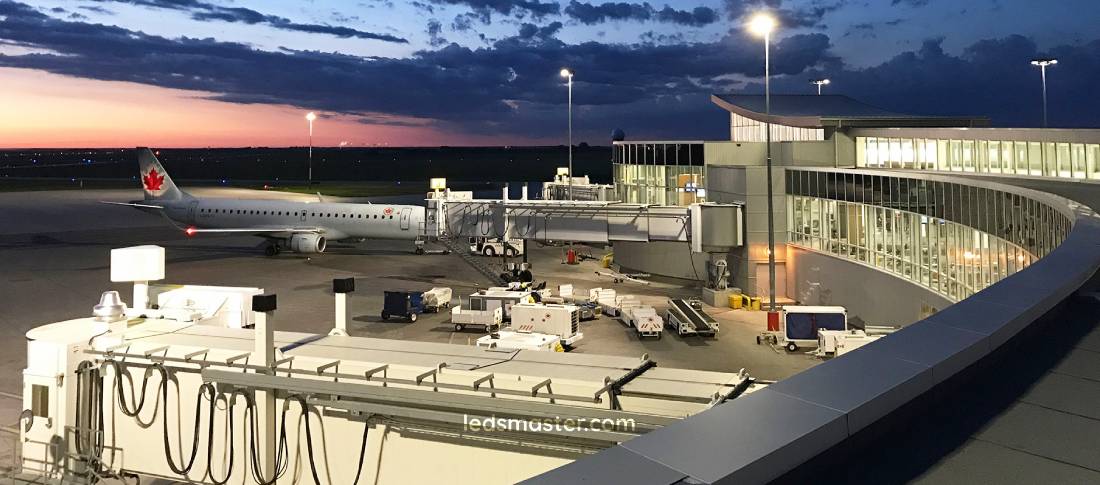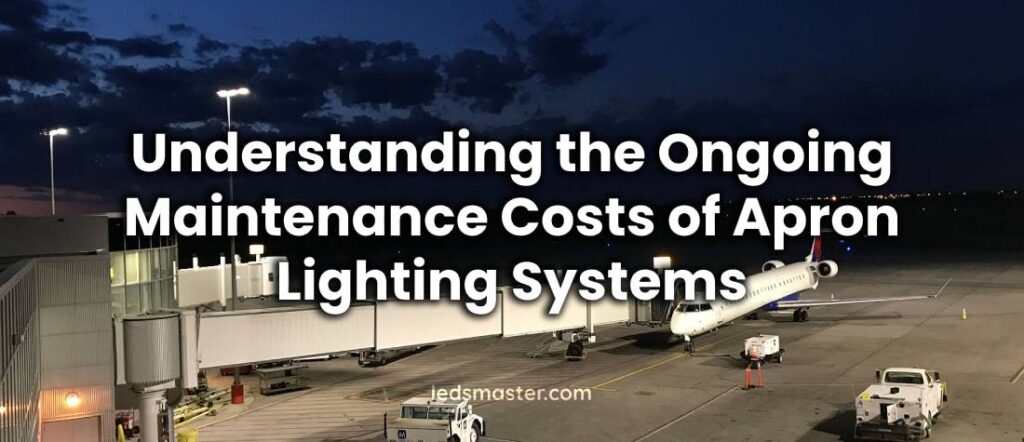Apron lighting systems are integral to the smooth functioning of airports. These lighting setups illuminate aircraft parking areas, taxiways, and the apron itself, ensuring visibility for safety and operational efficiency. However, maintaining these systems requires careful consideration of both operational costs and long-term financial planning. As airports continue to modernize, it is crucial to have a clear understanding of the ongoing maintenance expenses associated with apron lighting.
Table of Contents
ToggleTypes of Maintenance Costs for Apron Lighting Systems
| Maintenance Type | Cost Range | Details |
|---|---|---|
| Routine Inspections | $500 – $5,000 per inspection | Frequency varies by airport size; smaller airports may inspect 2-3 times per year, larger ones more frequently. |
| Replacing Faulty Components | $100 – $1,000 (bulbs/LED modules) | Bulbs and LEDs; larger components like transformers and controllers can range from $3,000 to $15,000. |
| Cleaning and Environmental Maintenance | $10,000 – $25,000 per year | Includes cleaning fixtures and clearing debris; costs higher in challenging environments (e.g., coastal areas). |
| Emergency Repairs | $2,000 – $20,000+ | Unforeseen repairs; electrical panels or multiple component failures may push costs higher. |
The maintenance of apron lighting systems is not a simple, one-off task. It involves a variety of ongoing costs, which must be carefully managed to ensure that the lighting system operates efficiently and safely. These costs can be broadly categorized into several types, each contributing to the overall expense. A clear understanding of these categories can help airport operators plan their budgets and ensure the longevity of the system.

Routine Inspections and Adjustments
Routine inspections form the backbone of any maintenance strategy for apron lighting systems. These inspections are not just about ensuring that the lights are working; they also include checking the electrical systems, wiring, and light fixtures to confirm that everything is functioning as it should. Technicians will typically examine the condition of bulbs, wiring insulation, the integrity of electrical connections, and the status of control panels and transformers. The airport’s maintenance team will also assess the lighting poles for any damage caused by weather, impact, or wear and tear.
Environmental conditions play a significant role in the effectiveness of these inspections. Airports located in areas that experience extreme weather—such as high winds, intense heat, or freezing temperatures—will need to inspect their systems more frequently, as these conditions can cause wear and tear on the components. For instance, regular checks will be needed to assess the impact of sandstorms, salt from ocean air, or snow and ice buildup, all of which can compromise the functionality of apron lights.
The cost associated with routine inspections depends on the size and complexity of the airport’s apron lighting system. Smaller airports may conduct these inspections only two to three times a year, with each inspection costing between $500 and $3,000. Larger airports, which have more extensive systems or higher traffic volumes, may need inspections as often as once a month, with each visit costing between $2,000 and $5,000. Therefore, annual inspection costs can range from $5,000 to $20,000 for a medium-sized airport. These inspections allow airport managers to detect minor issues before they escalate into more costly repairs or replacements.

Replacing Faulty Components
Apron lighting systems are composed of various components that are subject to wear and failure over time. The most commonly replaced items include bulbs or LED modules, wiring, sensors, transformers, controllers, and switches. As these systems are exposed to harsh environmental conditions such as rain, snow, and wind, they naturally experience degradation. Components may also wear out due to the sheer volume of usage, especially in busy airports where apron lights operate for long periods during the night.
The cost of replacing faulty components can vary greatly depending on the specific part that needs replacement. For example, incandescent or halogen bulbs can cost anywhere from $100 to $300 each, while LED lights, which are more energy-efficient and have a longer lifespan, may range from $200 to $1,000 per unit. The higher cost of LED modules is often offset by their lower energy consumption and longer lifespan, which reduces the frequency of replacements over the years.
Larger components, such as transformers and controllers, can add significantly to the maintenance cost. A single transformer, which is responsible for converting electrical power to the appropriate voltage for the lighting system, can cost between $3,000 and $7,000 to replace, depending on its size and complexity. Similarly, lighting controllers, which regulate the operation of the lights, can cost anywhere from $5,000 to $15,000, depending on the specific system configuration and technological features.
Airport managers must also factor in the cost of labor for the replacement of these components. The installation of complex systems such as controllers or transformers often requires specialized technicians, and the labor costs can add anywhere from $1,000 to $3,000 per installation, depending on the geographical location and the complexity of the task.
Cleaning and Environmental Maintenance
Cleaning and environmental maintenance are often overlooked when considering apron lighting system costs, yet they are a vital part of ensuring that the system functions effectively. Over time, light fixtures accumulate dust, dirt, and debris, which can reduce the intensity and efficiency of the lights. Regular cleaning is required to remove any obstructions, especially in high-traffic areas such as taxiways or loading zones where debris tends to accumulate. In some cases, the lenses of the lights may become cloudy or covered in grime, diminishing the quality of light output.
The cost of cleaning varies based on the size of the airport, the frequency of cleaning required, and the environmental conditions. In locations that experience frequent storms, heavy winds, or snow, the accumulation of dirt and debris can be substantial, requiring additional cleaning efforts. Additionally, airports located near industrial areas or along coastlines may need to contend with air pollutants or salt that accelerate corrosion on light fixtures and components.
Routine cleaning may cost airports between $10,000 and $25,000 annually, depending on the size and complexity of the apron lighting system. Airports in more challenging environments—such as coastal areas or regions with high air pollution—may face higher costs due to the need for more intensive cleaning efforts. Furthermore, as part of environmental maintenance, airports must regularly clear debris and vegetation around light poles to avoid any obstructions that could interfere with the illumination.
For example, snow removal is a significant part of environmental maintenance in colder regions, and this can cost airports anywhere from $5,000 to $15,000 per year, depending on snowfall amounts and the frequency of snow removal needed. Similarly, airports in high-wind areas may need to inspect light poles for damage caused by storms, adding further maintenance costs.
Emergency Repairs
While routine maintenance can mitigate many problems, unforeseen failures still occur, often requiring emergency repairs. These unplanned repairs are usually the most expensive type of maintenance because they tend to be urgent and can involve extensive labor and material costs. Emergency repairs are unpredictable and can range from small repairs to complete system failures that necessitate immediate action to restore functionality.
Common emergency repairs include the failure of electrical panels, light fixtures, and wiring. For example, when an electrical panel or circuit fails, repair costs can range from $2,000 to $10,000, depending on the severity of the issue. These costs include the replacement of parts, labor, and any necessary equipment to perform the repairs. In cases where the failure involves multiple components, such as an entire row of lights or a large electrical failure, costs can skyrocket to $20,000 or more.
The cost of emergency repairs also depends heavily on the location of the airport. For airports located in remote or less accessible areas, the cost of repairs may be higher due to the added logistics involved in transporting specialized equipment or technicians. Labor rates may also vary based on the region, with airports in more remote areas sometimes paying higher fees for qualified electricians or lighting technicians who may need to travel longer distances.
Airports with outdated systems or complex lighting setups may also find that their emergency repair costs are higher due to the difficulty in sourcing parts or finding technicians with the right expertise. For instance, if a rare or obsolete part is needed, the cost of replacement could be much higher, as special orders and expedited shipping would be necessary.
Overall, emergency repairs can cause disruptions in airport operations, making them not only costly but also time-sensitive. In addition to the monetary cost, there are operational disruptions that must be managed, such as delays in flight schedules or temporary safety concerns until the issue is resolved.

Factors Influencing Apron Lighting Maintenance Costs
Several factors influence the overall maintenance costs of apron lighting systems. These factors can affect how often maintenance is needed and how much it costs to maintain the system over time. Understanding these variables can help airport operators better plan for long-term costs.
Age of the Lighting System
The age of an apron lighting system is one of the most influential factors when determining maintenance costs. Older systems, particularly those that rely on traditional lighting technologies such as incandescent or halogen bulbs, require more frequent repairs and replacements. These systems also consume more energy, adding to operational costs.
In contrast, newer systems that use energy-efficient LED lights tend to have lower maintenance costs. LED lights last much longer than traditional bulbs and require less frequent replacement. Although the initial installation cost for LED systems can be higher, the long-term maintenance and energy savings are substantial. In fact, airports that switch to LED lights can reduce maintenance costs by 30% to 50% over the life of the system.
Location and Climate Conditions
The geographical location and local climate of the airport have a direct impact on maintenance costs. For airports located in areas with extreme weather conditions, such as heavy snow, ice, or high winds, the lighting system may require more frequent repairs due to environmental damage. For example, airports in cold climates may face higher cleaning costs in winter to prevent ice buildup around light fixtures.
Salt from sea air can also accelerate corrosion, requiring additional maintenance for airports located near coastal areas. In such cases, special coatings may be applied to prevent rust and corrosion, which adds to the overall maintenance expenses.
Technological Advancements
With advancements in technology, modern apron lighting systems have become more sophisticated, with smart features such as automatic dimming, motion detection, and remote monitoring. While these systems offer operational efficiency and energy savings, they also come with higher maintenance costs due to the complexity of the technology.
The cost of maintaining these advanced systems depends on the software and hardware infrastructure required to support them. For instance, maintenance teams may need to conduct software updates and check the communication systems to ensure smooth operation. Additionally, as these technologies evolve, it may require upgrading certain components, leading to added expenses.
Usage Intensity
The intensity of use of an airport’s apron lighting system can also affect maintenance costs. Airports that experience higher traffic volume will require more frequent maintenance as their systems are used more intensively. For example, airports with higher aircraft turnover may experience more wear and tear on their lighting fixtures, leading to more frequent replacements and repairs.
On the other hand, smaller regional airports with lower traffic volumes will likely have lower maintenance costs, as their lighting systems will not experience as much strain. Understanding the average usage rate and factoring this into the maintenance budget can help airport managers anticipate and plan for expected costs.
Managing and Reducing Apron Lighting Maintenance Costs
While apron lighting systems are an essential part of airport operations, there are strategies to manage and reduce maintenance costs over time. A proactive approach to maintenance, combined with the use of modern technologies, can help minimize unforeseen expenses and extend the lifespan of the system.
Scheduled Preventive Maintenance
One of the most effective ways to manage maintenance costs is through scheduled preventive maintenance. By planning inspections and part replacements in advance, airports can avoid the need for emergency repairs. This also allows maintenance teams to spot potential issues before they become major problems, reducing the likelihood of costly repairs.
Scheduled maintenance also helps to identify inefficient components early, enabling airport managers to replace them before they lead to higher energy consumption or safety issues.
Investment in Energy-Efficient Lighting Solutions
Switching to energy-efficient LED lighting can significantly reduce long-term maintenance costs. While the initial installation of LEDs can be more expensive, the savings in energy consumption and the longer lifespan of the bulbs lead to lower replacement and operational costs. LED lights require fewer replacements over time, which reduces both material and labor costs associated with their upkeep.
Additionally, LED lights produce less heat, reducing the strain on the system’s electrical components and lowering the likelihood of overheating or failures that require repairs.
Smart Maintenance Monitoring Systems
Implementing smart maintenance monitoring systems can provide real-time data on the performance of apron lighting systems. These systems can alert maintenance teams to potential issues, allowing them to address problems before they escalate. By integrating sensors and software, airports can track energy usage, monitor light output, and even identify faulty components remotely.
This technology enables more targeted maintenance efforts and reduces unnecessary checks and repairs, leading to cost savings.
Conclusion
The ongoing maintenance costs of apron lighting systems are influenced by a variety of factors, including the age of the system, local climate conditions, and the intensity of usage. Airports can manage these costs effectively by investing in preventive maintenance, modernizing their lighting systems, and utilizing technology to monitor and address issues proactively. While maintenance expenses are an unavoidable part of airport operations, a strategic approach to managing apron lighting systems can lead to long-term savings, enhancing both operational efficiency and budget predictability.

